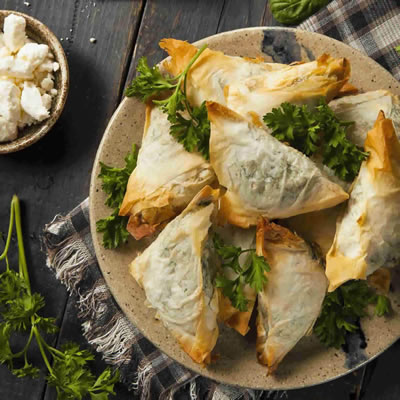
Phyllo Dough
Also Known As Filo dough
What is Phyllo Dough?
Phyllo is a type of unleavened pastry dough used to make sweet or savory baked goods. It is characterized by extremely thin sheets and a flaky, crispy texture when baked. It is similar to puff pastry but differs in separation and dry appearance of its sheets.
- As a prominent component of several Middle Eastern and Mediterranean dishes, phyllo is most famously used in preparing the Greek dessert, Baklava, as well as börek, Bülbül yuvası, and many others. 1
- Sheets of phyllo dough can be layered, folded, rolled or ruffled and further stacked to produce a variety of baked goods.1
Origin
Phyllo dough originated in Medieval Turkey in the 11 th century.1 During the First World War, Istanbul households used to have many phyllo makers on staff, for making various types of phyllo dough.1
Today, this dough is available all over the world and is sold in the supermarket’s frozen case.
Ingredients
Commonly used ingredients in phyllo dough:2
| Ingredient | Type | Usage level (Baker’s percent) | Function |
|---|---|---|---|
| Flour | Bread flour | 100 % |
|
| Water | Ice cold | 2.4 % |
|
| Fat | Oil (Vegetable or olive oil) | 0.1 % |
|
| Vinegar | White vinegar | 0.1 % |
|
| Salt | Granulated | 0.05 % |
|
Nutrition
Typical nutritional value of commercially available this dough per 100 g:3
| Component | Grams |
|---|---|
| Carbohydrate | 52.6 |
| Water | 32.6 |
| Protein | 7.1 |
| Fat | 6.0 |
| Ash | 1.6 |
*Composition may not add to a 100 g
Phyllo dough has a high fat and calorie content. A commercial dough provides 299 kcal per 100 g serving.
Commercial production
This dough is commercially produced through the following process:4
- Scaling, weighing and mixing of all the ingredients in a steel horizontal mixer.
- Dividing: dough is fed into a dividing machine to form balls.
- Kneading and sheeting: dough balls are kneaded and flattened by a sheeter machine.
- Stretching: Stretching to the desired dimensions.
- Drying: dough sheet is dried using infrared light.
- Cutting: Large dough sheets are cut into standard phyllo pieces.
- Stacking: 15 – 30 dough sheets are stacked on top of each other, and rolled together.
- Packaging: rolled stacks are packed in a vacuum sealed plastic bag, and later on deposited in a cardboard box.
- Storage: in freezers.
Application
When working with phyllo dough some considerations should be taken:5
- Thaw frozen phyllo dough completely before removing it from the plastic package to avoid breakage
- Stretch dough at room temperature. If frozen, wait at least 1 – 2 hours to thaw before stretching.
- After removing from the package, the dough should be covered with a damp towel to prevent drying.
- Pastries should be baked immediately.
- Fillings should be prepared before the dough is unrolled.
Some common pastries made with this dough are:5
- Baklava
- Napoleons
- Börek
- Bülbül yuvası
- Briks
- Gözleme
- Güllaç
- Bougatsa
Regulations
Phyllo dough uses common ingredients considered GRAS by the FDA. This dough has an established labeling guidance, just as many other baked goods.6
In the EU, phyllo dough belongs to the Cereal and Bakery Products category. Its ingredients are considered safe.7
References
- Davidson, A. The Oxford companion to food. OUP Oxford, 2014.
- Figoni, P. I. How Baking Works: Exploring The Fundamentals Of Baking Science. 3rd ed., John Wiley & Sons, 2011.
- U.S. Department of Agriculture, Agricultural Research Service. FoodData Central, 01 March 2019.https://fdc.nal.usda.gov/fdc-app.html#/food-details/172791/nutrients . Accessed 27 June 2021.
- “How It’s Made: Phyllo Dough”. How It’s Made, created by Gabriel Hoss, season 3, episode 11, Productions MAJ, 2003.
- Gisslen, W. Professional baking. No. 1. Wiley, 2019.
- Food and Drug Administration (FDA). US Department of Health and Human Services. CFR Code of Federal Regulations Title 21, Part 101 Food Labeling, https://www.accessdata.fda.gov/scripts/cdrh/cfdocs/cfcfr/cfrsearch.cfm?fr=101.54 , Accessed 27 June 2021.
- Food Safety Authority of Ireland. Guidance Note On The EU Classification Of Food. Food Safety Authority Of Ireland, Dublin, 2001.

